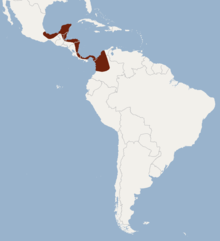| Cozumelan golden bat | |
|---|---|
| Conservation status | |
 Least Concern (IUCN 3.1) | |
| Scientific classification | |
| Domain: | Eukaryota |
| Kingdom: | Animalia |
| Phylum: | Chordata |
| Class: | Mammalia |
| Order: | Chiroptera |
| Family: | Phyllostomidae |
| Genus: | Mimon |
| Species: | M. cozumelae |
| Binomial name | |
| Mimon cozumelae Goldman, 1914 | |

| |
The Cozumelan golden bat (Mimon cozumelae) is a bat species found in Mexico, Guatemala, Belize, Honduras, Nicaragua, Costa Rica, Panama and Colombia. At one time, this species was considered to be a subspecies of the golden bat (Mimon bennettii). Little is known about the biology of this bat, but it has a wide range, no particular threats have been identified, and the population seems steady, so the International Union for Conservation of Nature has assessed its conservation status as being of "the least concern".
Taxonomy and etymology
It was described as a new species in 1914 by American zoologist Edward Alphonso Goldman. The holotype had been collected on Cozumel by G. F. Gaumer. At times, it has been considered a subspecies of the golden bat, Mimon bennettii.
Description
Its forearm length is 53.1–59 mm (2.09–2.32 in). Individuals weigh approximately 35 g (1.2 oz). It has a dental formula of 2.1.2.31.1.2.3 for a total of 30 teeth.
Biology and ecology
It roosts in small groups by day, mostly in limestone caves, but sometimes in hollow logs. It hunts at night and may glean prey from tree foliage. Its diet is known to include beetles, katydids, birds and lizards. Breeding takes place at the start of the rainy season, with females giving birth to a single offspring.
Range and habitat
The Cozumelan golden bat is a lowland species and is found in mature evergreen, semi-deciduous, and dry forest. It has been documented at a range of elevations from 0–600 m (0–1,969 ft) above sea level.
References
- ^ Arroyo-Cabrales, J.; Miller, B.; Reid, F.; Cuarón, A.D.; de Grammont, P.C. (2015). "Mimon cozumelae". IUCN Red List of Threatened Species. 2015: e.T136561A21991024. doi:10.2305/IUCN.UK.2015-4.RLTS.T136561A21991024.en. Retrieved 19 November 2021.
- Goldman, E.A. (1914). "A new bat of the genus Mimon from Mexico". Proceedings of the Biological Society of Washington. 27: 75–76.
- ^ Medellín, R. (2014). Ceballos, G. (ed.). Mammals of Mexico. JHU Press. pp. 700–701. ISBN 978-1421408439.
| Taxon identifiers | |
|---|---|
| Mimon cozumelae | |